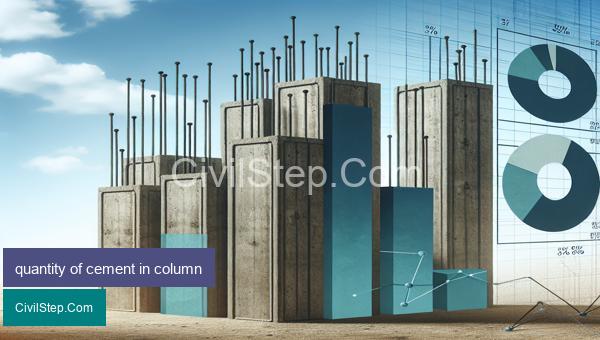
When it comes to construction, accurate calculations are crucial to ensure the stability and durability of any structure. This is particularly true for columns, which are the vertical load-bearing elements that support the weight of a building. Calculating the quantity of steel and concrete needed for a column is a critical step in the construction process that requires precision and thorough understanding of structural design. In this article, we will delve into the process of calculating the quantity of steel and concrete in a column, providing essential information and guidelines for accurate and efficient calculations. Whether you are a professional engineer, a construction worker, or simply curious about the process, this article will provide you with all the necessary insights for calculating the optimum amount of steel and concrete in a column.
How to calculate quantity of steel and concrete in column

Calculating the quantity of steel and concrete in a column is an essential part of the design and construction process for any civil engineer. This calculation ensures that the column can withstand the required load and provide the necessary structural stability. Here is a step-by-step guide on how to calculate the quantity of steel and concrete in a column:
1. Determine the column dimensions: The first step is to determine the dimensions of the column, including its length, width, and height. These dimensions will be used in the calculations for the column’s volume.
2. Calculate the volume of the column: The volume of the column can be calculated by multiplying the length, width, and height. This will give you the total volume of concrete that is needed for the column.
3. Determine the required strength of the column: The required strength of the column will depend on the building’s design and the load it has to support. This information can be obtained from the structural drawings.
4. Calculate the steel reinforcements needed: The amount of steel needed for the column can be calculated by multiplying the cross-sectional area with the required steel percentage. The cross-sectional area can be determined by multiplying the length of the column with its width.
5. Calculate the concrete required: Now, subtract the volume of the steel from the total column’s volume. The remaining volume will be the concrete needed to fill the column.
6. Convert volume to quantity: Once you have calculated the volume of concrete needed, you need to convert it into cubic meters as this is the standard unit for measuring concrete. You can do this by multiplying the volume in cubic meters by 1000.
7. Consider wastage and spacers: It is essential to add a percentage for wastage and spacers in the final calculation of the concrete quantity. Typically, a wastage factor of 5% to 10% and a spacer factor of 2% to 3% is added to the total quantity.
8. Check with the local building codes: It is crucial to check with the local building codes for the minimum required thickness of the concrete cover. This must be added to the overall dimension to make sure your column meets the safety standards.
9. Calculate the steel bar length: The length of the steel bars can be calculated by multiplying the number of bars with the total column’s length.
10. Consider the lap length: The lap length is the length of the overlap between two reinforcing bars. The lap length depends on the type of bar, the strength of the concrete, and the column’s diameter. It is essential to follow the lap length specifications to ensure the column’s strength and durability.
In conclusion, calculating the quantity of steel and concrete in a column is crucial for ensuring the structural stability and safety of the building. It is essential to follow the building codes and engineering standards during the calculation process to ensure a robust and reliable structure.
What is M20 grade of concrete

M20 grade of concrete is a commonly used and widely accepted design mix used in construction projects around the world. It is a medium strength concrete mix, usually used in the construction of buildings, bridges, and other structures where high strength is not a critical requirement.
The “M” in M20 stands for “mix” and the number 20 denotes the compressive strength of concrete in N/mm^2 after 28 days of curing. In other words, M20 grade concrete can withstand a compressive load of 20 megapascals (MPa) or 2900 pounds per square inch (psi) after 28 days.
The mix proportion of M20 grade concrete is 1:1.5:3, which means one part cement, one and a half parts coarse aggregates, and three parts of fine aggregates are used to make 1 cubic meter of concrete. The mix also includes water and may sometimes consist of chemical additives or admixtures to improve the workability and strength of the concrete.
One of the key features of M20 grade concrete is its moderate strength and workability, making it suitable for a variety of construction applications. It can be used for foundation slabs, columns, beams, and other structural elements of a building. Its moderate strength also makes it suitable for pavement construction and other non-structural applications.
To achieve the required strength, M20 grade concrete needs to be properly cured for a minimum of 28 days. Curing involves keeping the concrete moist and at a suitable temperature to allow it to gain strength and achieve its maximum potential. Without proper curing, concrete may develop cracks and have reduced strength, which can compromise the stability and durability of a structure.
In addition to its strength and workability, M20 grade concrete also has good durability and can withstand weathering and chemical attacks. However, it is always recommended to use appropriate cover to protect the concrete from external factors such as moisture and corrosive substances.
Overall, M20 grade of concrete is a popular choice for construction projects due to its balanced strength and workability, making it cost-effective and suitable for a wide range of applications. It is important to follow proper mix proportions, curing techniques, and quality control measures to ensure the desired strength and durability of M20 grade concrete.
How to calculate quantity of concrete in column

Calculating the quantity of concrete required for a column is an essential task in construction. It is crucial to determine the correct amount of concrete as it directly impacts the structural stability and cost of the project. Here are the steps to calculate the quantity of concrete in a column:
1. Determine the dimensions of the column: The first step is to determine the dimensions of the column, including the length, width, and height. Typically, the height of a column is measured from the base to the top of the column, including the beams or slabs attached to it.
2. Calculate the cross-sectional area: The cross-sectional area of the column is necessary to determine the volume of concrete required. To calculate the cross-sectional area, use the formula A = πr^2, where A is the area and r is the radius of the column. If the column is rectangular, the area can be calculated by multiplying the length and width.
3. Calculate the volume of concrete: Once you have the cross-sectional area, the next step is to calculate the volume of concrete required for the column. This can be done by multiplying the cross-sectional area by the height of the column. The formula for calculating the volume of a column is V = A x h, where V is the volume, A is the cross-sectional area, and h is the height of the column.
4. Account for reinforcement: In most cases, columns are reinforced with steel bars to increase their strength and stability. The amount of reinforcement needed depends on the structural design and load-bearing capacity of the column. You can consult the structural engineer or refer to the structural drawings to determine the quantity of reinforcement required.
5. Add allowances for wastage: It is essential to account for wastage of concrete during the construction process. A general rule of thumb is to add an additional 5-10% of the total concrete quantity to account for any spillage, overflows, or curing losses.
6. Calculate the total quantity of concrete: To calculate the total quantity of concrete required for the column, add the volume of concrete (calculated in step 3) and the amount of reinforcement (calculated in step 4) with the allowance for wastage (calculated in step 5).
7. Convert the volume to the number of bags of concrete: Once you have the total volume of concrete required, you can convert it to the number of bags of cement needed by dividing the total volume by the volume of one bag of cement. This may vary depending on the type of cement and its density.
In conclusion, calculating the quantity of concrete in a column is a simple but crucial process in construction. It is essential to follow these steps accurately to ensure the structural integrity and stability of the column. Consulting with a structural engineer and referring to the structural drawings can also help in determining the correct amount of concrete required.
Steel calculation for column

Steel calculation for column is an important aspect in the design and construction of structures. Columns are vertical structural elements that support the weight of the building and transfer it to the foundation. Hence, it is crucial to determine the correct amount of steel required for a column to ensure its strength and stability.
The following are the steps involved in steel calculation for column:
1. Determine the column dimensions: This includes the length, width, and height of the column. The dimensions may vary depending on the type of building and the load it is expected to bear.
2. Determine the load on the column: The type of load on the column can be dead load (weight of the structure itself), live load (occupants and furniture), wind load, and seismic load. The magnitude of these loads needs to be calculated accurately to determine the steel requirement.
3. Determine the maximum stress on the column: The maximum allowable stress on a column is typically 0.66 times the yield stress of the steel. This can be calculated by dividing the maximum load on the column by the cross-sectional area of the column.
4. Select the type of steel and its grade: The type and grade of steel chosen play a crucial role in the strength and stability of the column. Steel grades commonly used in columns are Fe250, Fe415, and Fe500.
5. Determine the number of steel bars: The number of steel bars required for a column depends on the cross-sectional area of the column, the spacing between the bars, and the diameter of the bars. The spacing between the bars is usually 4 inches, and the diameter can range from 10mm to 25mm.
6. Calculate the length of steel bars: The length of steel bars is determined based on the column dimensions and the spacing between the bars. The overlap length of the bars at the bottom and top of the column needs to be considered to ensure proper bonding with the concrete.
7. Determine the total weight of steel: Once the number and length of steel bars are calculated, the total weight of steel required for the column can be determined. This can be further used to determine the total cost of steel for the column.
In conclusion, steel calculation for columns is a critical process in the design of structures. It ensures that the columns can withstand the loads and provide the required strength and stability to the building. The accuracy of the steel calculation is vital to ensure the safety and durability of the structure.
quantity of cement in column

The quantity of cement in a column is a critical aspect of its construction that directly affects its strength and durability. As a civil engineer, it is essential to fully understand the factors that determine the amount of cement required in a column.
The amount of cement in a column is primarily dependent on its dimensions and the structural design. The dimensions of the column, including its height, cross-section area, and spacing, determine the volume of concrete used. The structural design, on the other hand, considers the load-bearing capacity and the required compressive strength of the column. The higher the load and strength requirements, the greater the amount of cement needed.
The standard practice for estimating the quantity of cement in a column is by using the concrete mix design approach. This approach involves calculating the volume of concrete required for the specified dimensions and strength requirement of the column. The mix design also takes into consideration the water-cement ratio, which is crucial in achieving the desired compressive strength.
The quantity of cement in a column is usually expressed in terms of bags, with one bag weighing 50 kg. Depending on the mix design, the amount of cement in a column can vary from 7 to 12 bags per cubic meter of concrete. For instance, a column with a cross-sectional area of 0.3 square meters and a height of 3 meters would require approximately 6 bags of cement for a conservative mix design with a water-cement ratio of 0.5.
It is important to note that the quantity of cement in a column also depends on the type of cement used. Ordinary Portland Cement (OPC) and Portland Pozzolana Cement (PPC) are the two commonly used types of cement in column construction. OPC has a higher compressive strength compared to PPC, and therefore, less amount of OPC is required to achieve the same strength as PPC.
In conclusion, the quantity of cement in a column is determined by various factors such as dimensions, load-bearing capacity, and the structural design. Proper calculation and consideration of these factors are crucial in achieving a strong and durable column. As a civil engineer, it is essential to understand the mix design approach and the different types of cement to accurately determine the amount of cement required in a column.
Conclusion
In conclusion, understanding how to calculate the quantity of steel and concrete in a column is crucial for any construction project. By following the steps outlined in this article, you can accurately determine the required amount of materials for your column, avoiding any wastage or delays in construction. Additionally, it is essential to keep in mind the governing codes and standards when performing these calculations to ensure the structural integrity of the column. With a thorough understanding of this process, you can confidently create stable and durable columns for your building. Happy calculating!
